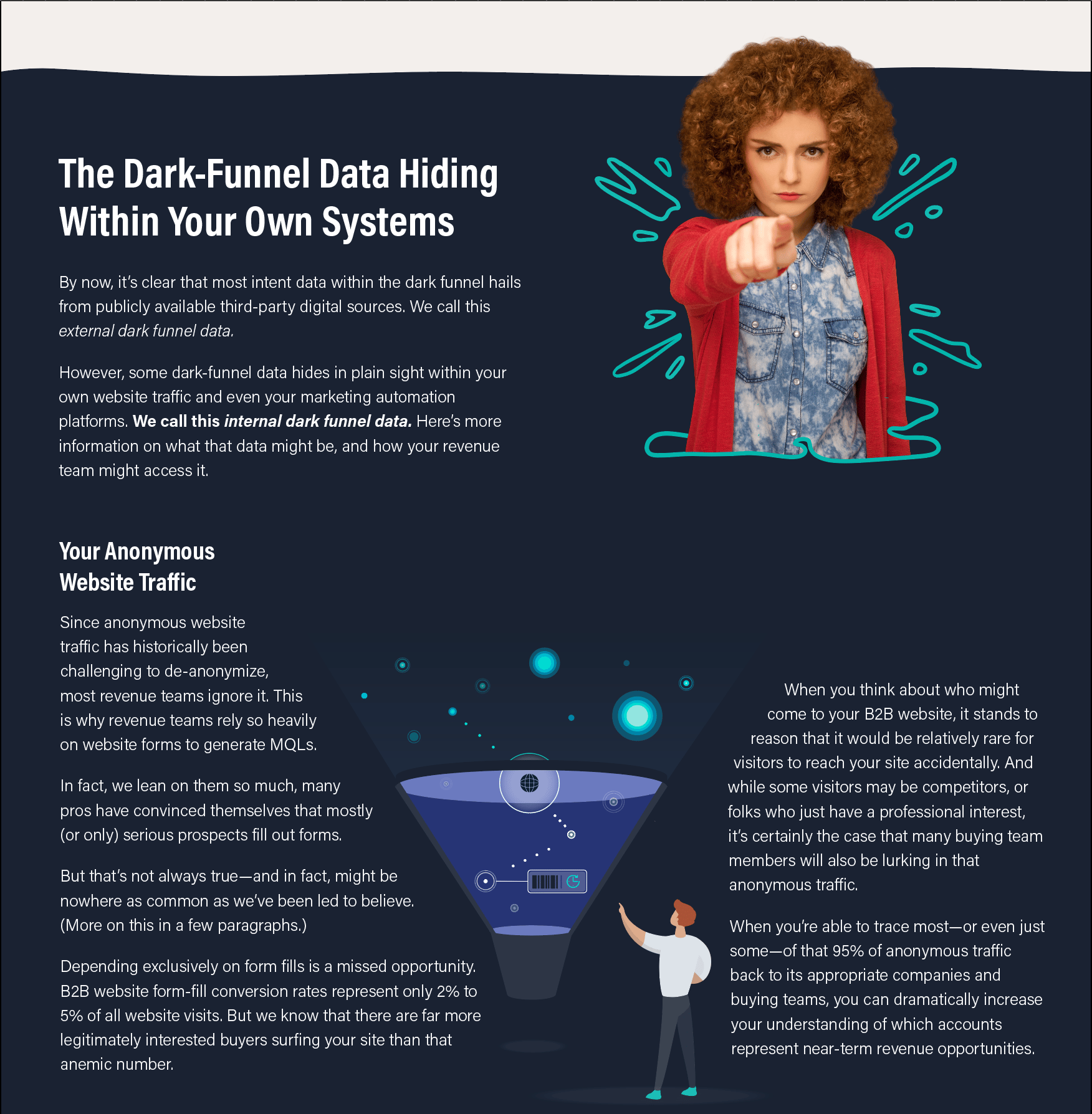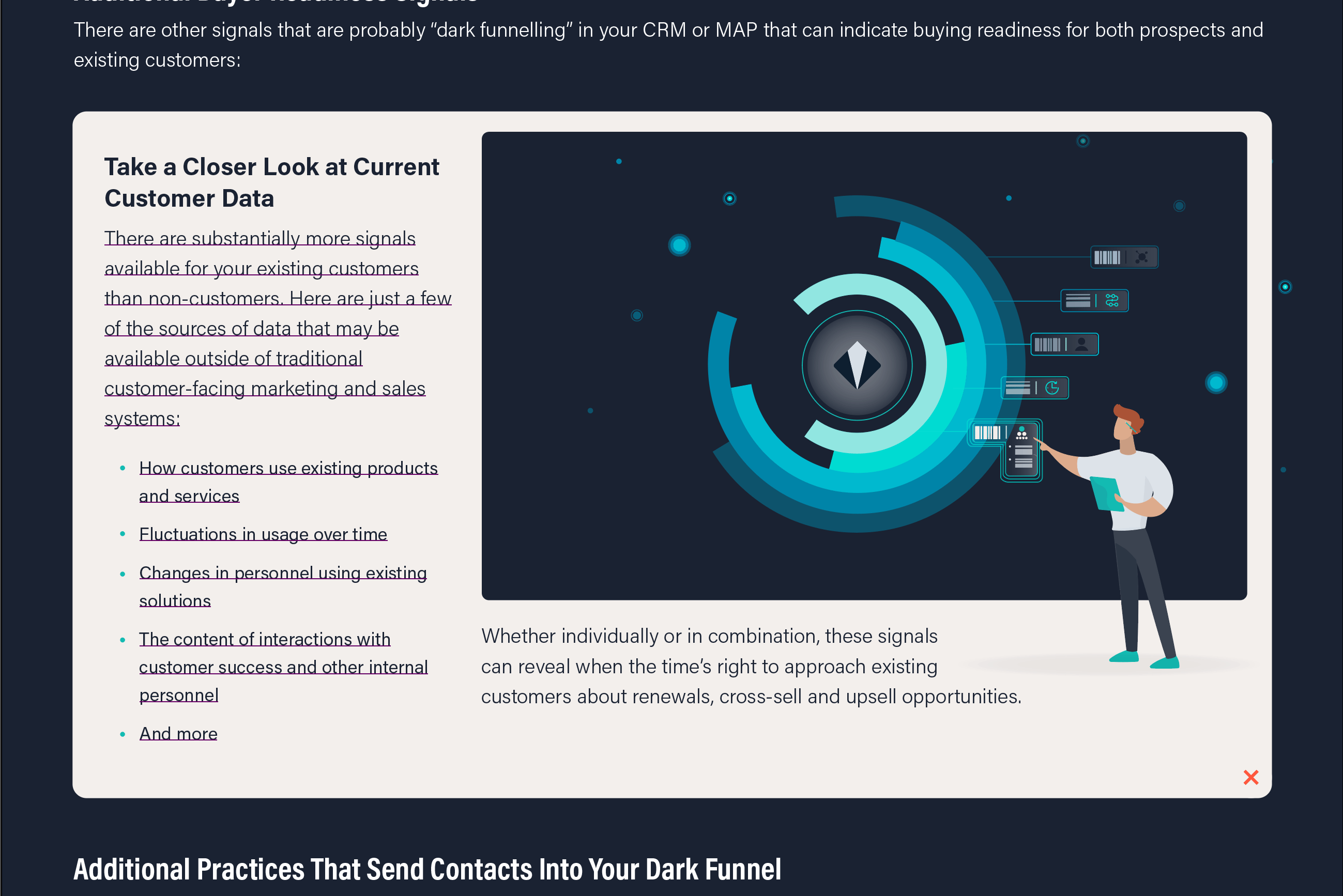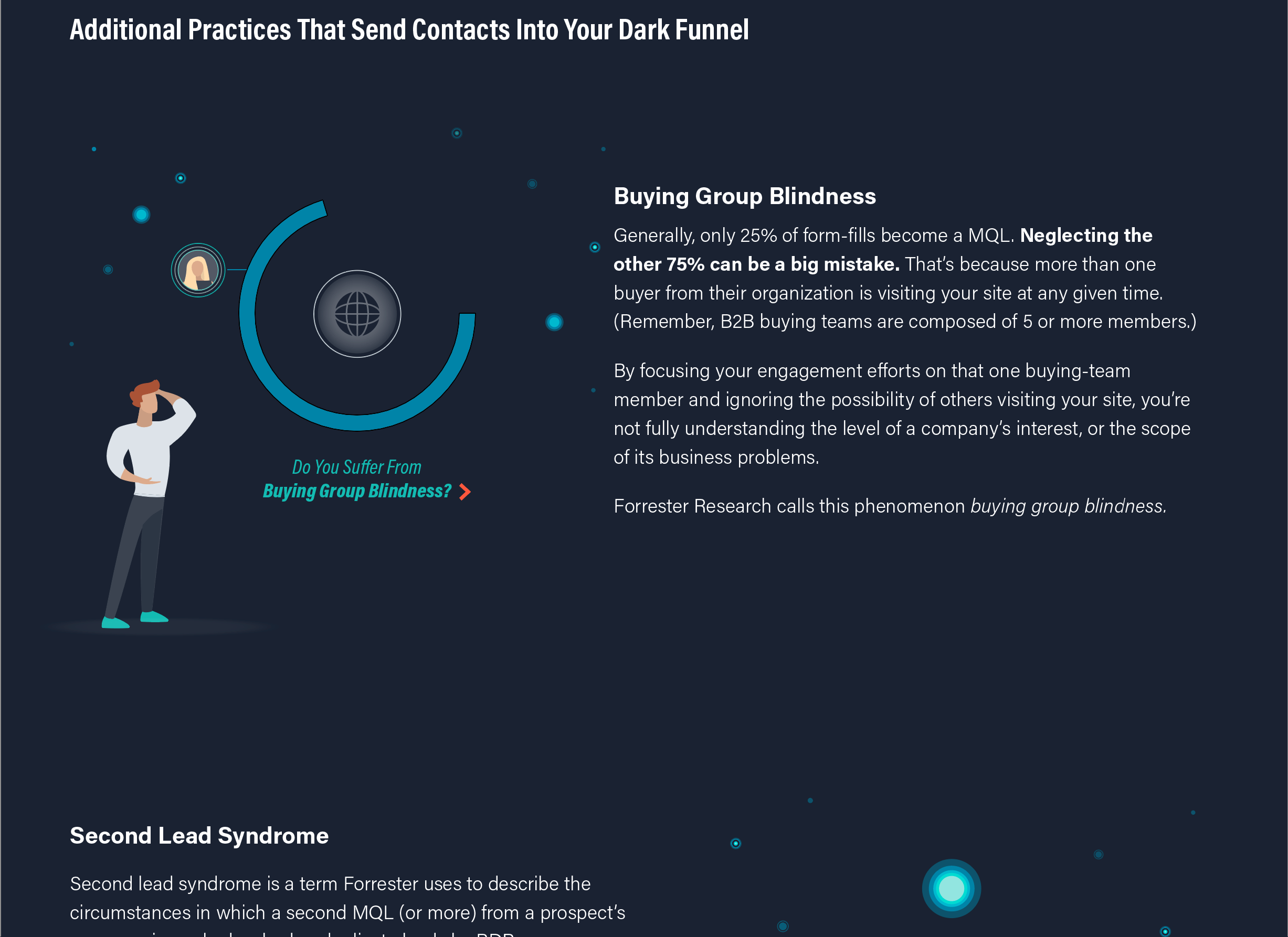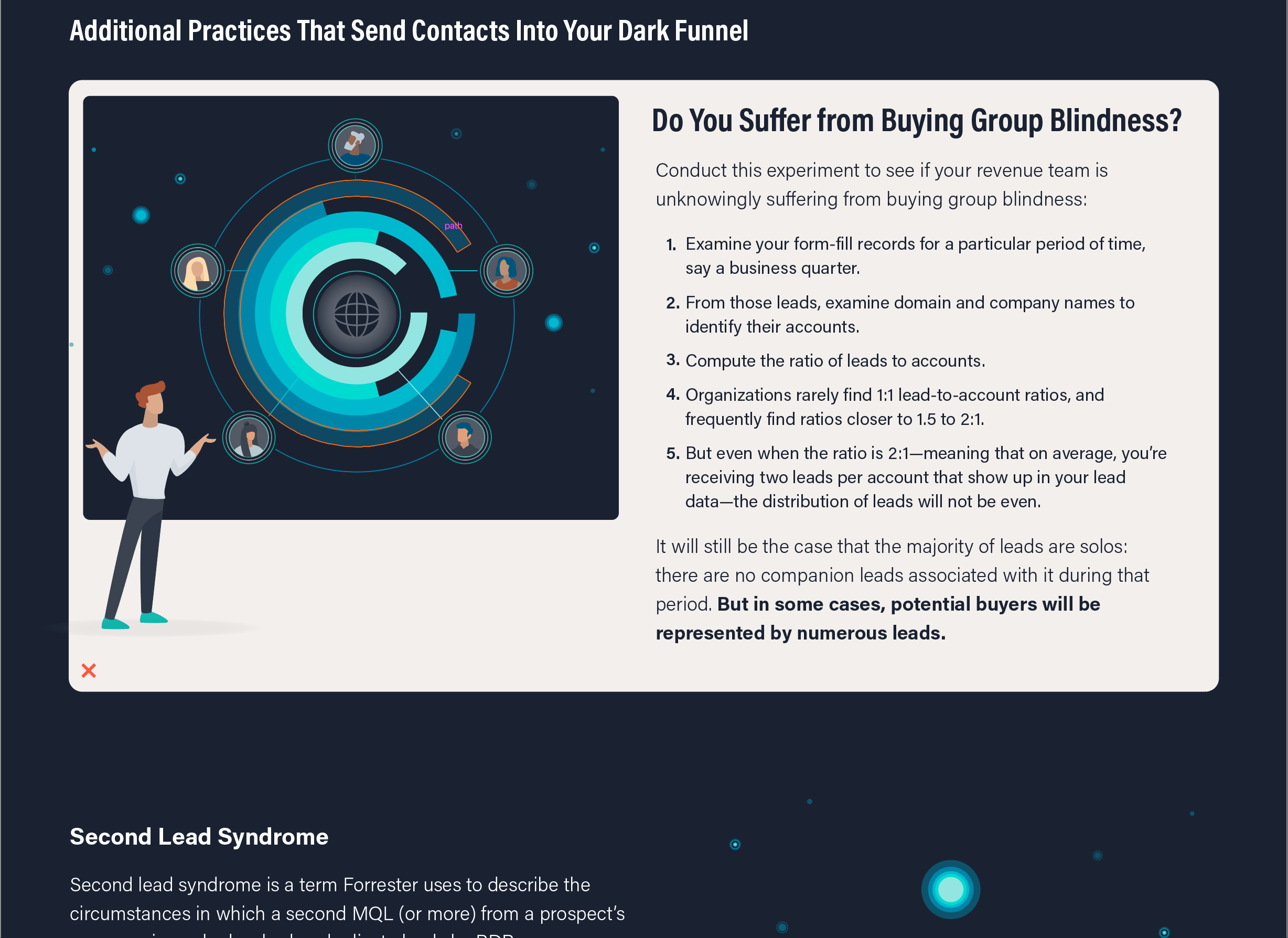






The Dark-Funnel Data Hiding Within Your Own Systems
By now, it’s clear that most intent data within the Dark Funnel hails from publicly available third-party digital sources. We call this external Dark Funnel data.
However, some Dark Funnel data hides in plain sight within your own website traffic and even your marketing automation platforms. We call this internal Dark Funnel data. Here’s more information on what that data might be, and how your revenue team might access it.
Your Anonymous Website Traffic
Since anonymous website
traffic has historically been
challenging to de-anonymize,
most revenue teams ignore it. This
is why revenue teams rely so heavily
on website forms to generate MQLs.
In fact, we lean on them so much, many
pros have convinced themselves that mostly
(or only) serious prospects fill out forms.
But that’s not always true—and in fact, might be
nowhere as common as we’ve been led to believe.
(More on this in a few paragraphs.)
Depending exclusively on form fills is a missed opportunity. B2B website form-fill conversion rates represent only 2% to 5% of all website visits. But we know that there are far more legitimately interested buyers surfing your site than that anemic number.
When you think about who might come to your B2B website, it stands to reason that it would be relatively rare for visitors to reach your site accidentally. And while some visitors may be competitors, or folks who just have a professional interest, many buying team members will also be lurking in that anonymous traffic.
When you’re able to trace most—or even just some—of that 95% of anonymous traffic back to its appropriate companies and buying teams, you can dramatically increase your understanding of which accounts represent near-term revenue opportunities.
































Additional Buyer Readiness Signals
There are other signals that are probably “dark funnelling” in your CRM or MAP that can indicate buying readiness for both prospects and existing customers:
























Take a Closer Look at Current Customer Data
























Re-examine Closed/Lost Data
For example, when deals are closed as lost, revenue teams can usually determine:
Which company won the deal
The broad terms of why the deal was lost
The timing for when that lost deal will be up for renewal with the winner
This information can be used to tailor future marketing and sales efforts to displace the current provider.
Take a Closer Look at Current Customer Data
There are substantially more signals available for your existing customers than non-customers. Here are just a
few of the data sources that may be available outside of traditional customer-facing marketing and sales systems:
How customers use existing
products and services
Fluctuations in usage over time
Changes in personnel using
existing solutions
The number of interactions with customer success and other
internal personnel
And more
Whether individually or in combination, these signals can reveal when the time’s right to approach existing customers about renewals, cross-sell and upsell opportunities.
Additional Practices That Send Contacts Into Your Dark Funnel

















Do You Suffer From
Buying Group Blindness?



























Generally, only 25% of form-fills become a MQL. Neglecting the other 75% can be a big mistake. That’s because more than one buyer from their organization is visiting your site at any given time. (Remember, many B2B buying teams are composed of 10+ members.)
Buying Group Blindness
By focusing your engagement efforts on that one buying-team member and ignoring the possibility of others visiting your site, you’re not fully understanding the level of a company’s interest, or the scope of its business problems.
Forrester Research calls this phenomenon buying group blindness.
Conduct this experiment to see if your revenue team is unknowingly suffering from buying group blindness:
Do You Suffer from Buying Group Blindness?
Examine your form-fill records for a particular period of time, such as a business quarter.
1.
From those leads, examine domain and company names to identify their accounts.
2.
Compute the ratio of leads to accounts.
3.
Organizations rarely find 1:1 lead-to-account ratios, and frequently find ratios closer to 1.5 to 2:1.
4.
But even when the ratio is 2:1—meaning that on average, you’re receiving two leads per account that show up in your lead data—the distribution of leads will not be even.
5.
It will still be the case that the majority of leads are solos: there are no companion leads associated with it during that period. But in some cases, potential buyers will be represented by numerous leads.

















An Example of
Second Lead Syndrome
























Second lead syndrome is a term Forrester uses to describe the circumstances in which a second MQL (or more) from a prospect’s company is marked as bad or duplicate leads by BDRs.
Second Lead Syndrome
This is another internal misstep that can dump great leads into your Dark Funnel, never to be seen again.
Leads that are related to the same solution should be bundled together for the sales and sales development teams. Ideally, the presence of multiple members of the buying team would prioritize that opportunity above opportunities exhibiting few buying signals.
Here’s how an internal sales process can toss actionable account data straight into the Dark Funnel:
An Example of Second Lead Syndrome
An employee at Acme Co. visits your website, consumes content and converts into an MQL
The Acme Co. MQL is passed to the BDR team
A BDR qualifies the prospect and passes the prospect on to sales
The following week, another buying-team member from Acme Co. also qualifies as an MQL
The BDR receives this second MQL, but notes that the first lead from Acme Co. was already qualified
The BDR marks this new MQL as a duplicate
The second MQL is discarded
This means sales isn’t notified that another member of Acme Co.’s buying team is displaying additional interest … which compromises the team’s understanding of the deal and its buyers
Analyzing customer data is also vital for upselling and preventing churn. Learn more via the graphic on the right.